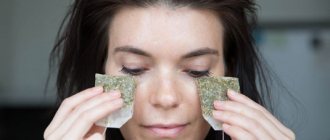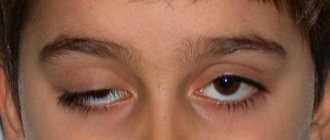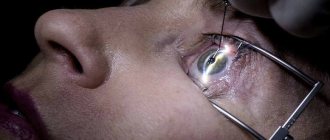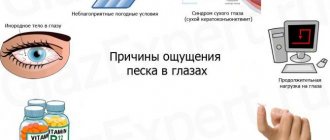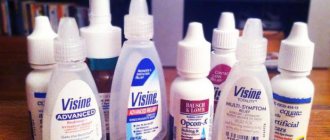Mechanism of hydration of the eyeball
On the surface of the eye there is a transparent protective film that covers the cornea and consists of three layers:
- The first, formed by fats. It protects the film from drying out the liquid. In addition, the oily secretion produced by the meibomian glands allows the eyelid to slide easily;
- The second, consisting of tear fluid. It nourishes the cornea and performs a protective function by washing away foreign bodies. In addition, the layer is involved in the refraction of light;
- The third, adjacent to the cornea. This is the mucous layer that makes the surface of the cornea smooth and ensures its tight adhesion to the tear film.
The thickness of the tear film does not exceed 10 micrometers. Approximately every 10 seconds. it is renewed again and initiates the blinking of the eyelids. It is disturbances in the tear film that cause dry eye syndrome.
Delphanto® capsules – effective prevention of dry eye syndrome
One of the methods for preventing dry keratoconjunctivitis is chemical tear substitutes. But such drugs provide temporary hydration of the cornea, so patients are forced to use them constantly.
The optimal option for preventing dry eye syndrome today is taking Delphanto® capsules. This is a unique drug that helps eliminate symptoms of “dry eyes” by increasing the production of tear fluid. It has several advantages:
- convenient release form;
- the first results are noticeable after 2-3 weeks;
- no dependence on tear substitutes;
- elimination of dry eye syndrome by improving physiological processes.
The uniqueness of Delfanto® lies in its composition. The active ingredient of the capsules is a standardized extract from the berries of the Aristotelia Chilensis plant. It contains a large amount of antioxidants that help eliminate the effects of oxidative stress. The active substances included in the capsules help restore the function of lacrimal gland cells and stimulate the production of full tears in quantities sufficient to moisturize the cornea.
Composition and functions of the tear film
Normally, the entire anterior surface of the eyeball is covered with precorneal tear film. It smoothes out minor optical defects of the cornea, protects the cornea and conjunctiva from mechanical trauma and the harmful effects of certain environmental factors. The components of the tear film are produced by small glands located along the edges of the eyelids. The tear fluid flows out through special lacrimal ducts.
The precorneal tear film consists of the following layers:
- External lipid. Contains a large amount of fats that perform a protective function. This layer prevents moisture evaporation and protects the eye from drying out.
- Medium water. Provides the delivery of oxygen and nutrients to the cornea of the eye. It also removes harmful metabolic products and dead cells from the surface of the eyeball.
- Internal mucin. It has hydrophilic properties, which allows it to retain the tear film on the surface of the cornea.
Disruption of the normal structure of the tear film leads to dry eye syndrome. The conjunctiva and cornea dry out, which is why the person begins to experience a lot of discomfort. Over time, due to a lack of oxygen and nutrients, the patient's cornea and conjunctiva of the eyeball may become damaged.
Causes of dry eyes
Often, the causes of dry eye syndrome are:
But sometimes, the reasons can be more serious:
- Endocrine system disruptions , accompanied by a decrease in estrogen production. Most often this happens during perimenopause or menopause;
- Parkinson's disease;
- Autoimmune diseases , when the body begins to produce antibodies against its own cells and tissues (Sjogren's syndrome);
- Connective tissue diseases , such as scleroderma. This condition is characterized by the uncontrolled proliferation of dense connective tissue. In this case, the excretory ducts of all glands, including the lacrimal ones, are clogged. As a result, tear fluid is produced in insufficient quantities and is unevenly distributed over the surface of the eye;
- Diseases of the kidneys and urinary system;
- Injuries and any other conditions in which the eyelid cannot close completely;
- Severe exhaustion;
- Infectious skin diseases (for example, epidemic pemphigus);
- Regular use of oral contraceptives, antihistamines and corticosteroid medications. Vasoconstrictor eye drops can also reduce the production of tear fluid;
- Genetic predisposition;
- Surgical interventions on the eyes and eyelids (blepharoplasty, anterior keratotomy, keratoplasty, photoablation of the cornea and many others).
The risk group consists of the following categories of people:
- Office workers who stay at the monitor for more than 6 hours a day;
- Residents of megacities and other settlements with polluted air;
- Residents of mountainous areas;
- People over forty years of age;
- Women during pregnancy and menopause.
Types of drops for dry eyes
When dryness and discomfort occur in the eyes, it is not recommended to use the first moisturizer that is offered at the pharmacy. Sometimes it is necessary not only to moisturize the outer mucous membrane, but also to remove the cause that caused the pathology. It is necessary to consult an ophthalmologist so that he can examine the affected area and prescribe an effective treatment option. Types of drops:
- Antibacterial drugs . They are used if the cause of dry mucous membranes is an infection. Such medications block the action of harmful microbes, remove discomfort and redness.
- Vasoconstrictors . If the eyes are constantly under tension, the blood vessels dilate and become injured, drops help eliminate burning and redness. Thanks to this remedy, the vascular system of the visual organs is strengthened.
- Vitamin drops for dry eye syndrome provide additional nutrition. They compensate for the lack of useful components and are widely used to prevent eye pathologies.
- The therapeutic category of drugs gives a chance to get rid of specific diseases diagnosed by an ophthalmologist. Such remedies fight the source of the disease and its symptoms.
- Moisturizing eye drops help eliminate dryness and discomfort in the visual organs for a long period of time.
- Antihistamine drops for dry eyes are prescribed in case of excessive tearing and redness of the mucous membrane caused by food or seasonal allergies.
- How to pick up a car from an impound lot
- How to knit booties with knitting needles
- Fitness classes at home for weight loss
Moisturizing
This type of remedy for dry eyes is considered the safest, so they are prescribed to adults and children. A moisturizing solution is a liquid that has a composition very similar to human tears. It is necessary for those who constantly wear contact lenses or often work at the computer. The most popular drugs in this group:
- Lecrolin . These are drops in the eyes for dryness and pain. The product has an antihistamine effect, normalizing the functions of the visual organs and eliminating the inflammatory process. The drug has virtually no side effects, so it can be used for a long time. The main substance of the drops is sodium cromoglycate. Contraindications: allergy to the constituent components of Lecrolin. Drops for dryness cost from 85 to 90 rubles per bottle.
- Cromohexal based on sodium cromoglycate has an antiallergic and protective effect. It is a keratoprotector - a remedy that restores the tear film, which is destroyed due to frequent overstrain of the visual organs. The drug should not be given to children under two years of age if they are hypersensitive to the elements of the drug. During pregnancy and lactation it is used with caution. Side effects: burning, blurred vision, dryness, swelling of the conjunctiva, barley. The average price of Cromohexal is 100 rubles per package.
- Systane Ultra effectively fights irritation and helps regenerate the tear film. The drug can be used without removing contact lenses. It includes polyethylene glycol, sodium hydroxide, boric acid and other components. Contraindications: age under 5 years, allergy to the components of the drops. Sometimes side effects occur - irritation, lacrimation. The approximate cost of the drug is 450-600 rubles.
- Natural tear . This product has an almost identical composition to human tear secretion. Drops are used to restore its deficiency in the presence of symptoms of dry eye syndrome. Active ingredients: hypromellose, dextran. Natural tears are contraindicated in children under 18 years of age and those with individual intolerance to the drug. As a rule, the medicine does not cause side effects, but sometimes an allergic reaction may occur to it. The price of the product in Moscow and the region is 240-320 rubles.
- Oksial . This solution with a moisturizing effect, made on the basis of hyaluronic acid, softens dry conjunctiva and cornea. The process of restoration of the functions of the visual organs is significantly accelerated. Dry eye drops may cause irritation, but in very rare cases. The cost of Oksial is 350-450 rubles.
- “Cornflower blue” drops or Innoxa are classified as hypoallergenic products. The medicine includes natural ingredients: extracts of cornflower, chamomile, elderberry, and sweet clover. Eye drops relieve fatigue, eliminate dryness and irritation, and have an anti-inflammatory effect. The drug should be prescribed with caution to children under 14 years of age. Innoxa is contraindicated if you are allergic to plant elements from the composition. Adverse reactions almost never occur. You can purchase the medicine for 500-550 rubles.
- Cationorm is a unique cationic emulsion for moisturizing the eyes, which restores all three layers of the tear film, permanently eliminating severe, intense discomfort and dry eyes that appear throughout the day, even in the morning, and prevents the further development of dry eye syndrome. Cationorm does not contain preservatives and can be used in conjunction with contact lenses. Cationorm is suitable for people with severe complaints of dryness and eye discomfort, which manifest themselves even in the morning; people who wear contact lenses for a long time (more than 6 months, more than 5 days a week and/or more than 10 hours a day); people with other eye diseases (glaucoma, blepharitis, allergic conjunctivitis); people using hormone replacement therapy (menopausal hormones, oral contraceptives).
- Ocutiarz - eye drops with ultra-high molecular weight hyaluronic acid without preservatives to quickly eliminate discomfort and eye fatigue that appears at the end of the day after intense visual work. Ocutiarz is stored for 6 months after opening the bottle, it can be instilled onto contact lenses, and it is also often used to eliminate discomfort after ophthalmological operations on the cornea. Okutiarz is suitable for people with complaints of dry eyes occasionally, in the evening, after intense visual work (computer/office syndrome in office employees, motorists/motorcyclists, frequent fliers, travelers, students); people who have recently worn contact lenses are just learning to use them (to make it easier to remove and put on lenses); people within 6 months after eye surgery (LASIK, PRK, cataract extraction).
- Oftagel is an eye gel with carbomer in maximum concentration, which moisturizes for a long time, eliminates lacrimation and does not require frequent instillation; in addition, it can be used once at night, if it is not possible to instill moisturizing drops during the day. Oftagel is suitable for people with complaints of periodic dry eyes and/or lacrimation and an unwillingness/inability to instill drops more than once a day.
Systane Ultra, Alcon
Relieving fatigue
This group of medications has a stimulating effect. They include vitamins and relieve tension well, help eliminate dry eye syndrome, and preserve clarity of vision. The most effective means:
- Emoxipin . These eye drops for dryness and fatigue are a synthetic antioxidant. The active ingredient is methylethylpyridinol. The drug strengthens the eye vessels, promotes the resorption of minor hemorrhages, protects the retina and cornea from the negative effects of the sun. Adverse reactions: mild burning and tingling, redness or swelling of the conjunctiva, mild pain. The drug should not be used during pregnancy or high sensitivity to the composition. The average price is 200-300 rubles.
- Taufon . The drug is often prescribed for the treatment of cataracts and the removal of various types of dystrophic processes. Drops have a regenerating and energy-generating effect, improve metabolic processes in the visual organs. 1 ml of the drug contains 40 mg of the active substance - taurine. The medicine is prohibited for use if you are allergic to its constituent elements, pregnant, lactation, or under 18 years of age. Redness, burning, and cloudiness in the eyes may appear. The approximate cost of Taufon is 40-50 rubles.
- Oftan katachrome . The drug is used to block the development of cataracts, relieve swelling, and moisturize the mucous membrane. The composition of the medicine includes: nicotinamide, adenosine and cytochrome. It is not recommended to use it in case of individual intolerance; children under 18 years of age cannot be treated with it. After use, a short, mild tingling sensation may occur. Side effects: itching and rash on the skin of the face, redness, contact dermatitis (in rare cases - nausea, decreased blood pressure, weakness, fever). Oftan price is from 150 to 200 rubles.
- Quinax dry eye drops are also effective for treating cataracts. They help actively dissolve protein compounds that are deposited on the lens of the visual organ. Main active ingredient: sodium polysulfonate azapentacene. With regular use, the drug protects the eyes well from the effects of free radicals formed. Contraindication: allergy to the components of the product. No side effects were recorded. The average cost of Quinax is 350-550 rubles per package.
Vasoconstrictors
Such drugs are prescribed to eliminate pain and discomfort, which are symptoms of severe dry eye syndrome. The solutions have an antiseptic, anesthetic and vasoconstrictor effect, and well moisturize the outer mucous membrane. Examples of effective medications:
- Vitabact . This drug for the treatment of diseases of the anterior edge of the eyeball (keratitis, conjunctivitis) has an antiseptic, antimicrobial effect, destroys pathogenic microorganisms, some viruses and fungi. The active ingredient in Vitabact is picloxidine dihydrochloride. The drug should not be used when carrying a child, breastfeeding, or hypersensitivity to the constituent elements of the drug. After use, a burning sensation and hyperemia (swelling, redness) of the mucous membrane may appear. The price varies from 300 to 330 rubles.
- Okomistin solution is very effective for the treatment of diseases of the visual organs, which are caused by fungi, chlamydia, viruses, gram-negative and gram-positive bacteria. The product is made on the basis of the medicinal compounds ammonium chloride monohydrate and benzyldimetrile. Contraindications: patient age under 18 years, pregnancy and lactation, allergy to constituent components. Sometimes after use there is a burning sensation and slight discomfort that goes away within 20-30 minutes. The cost of Okomistin is 80-100 rubles.
- Octilia . This vasoconstrictor is an alpha-adrenergic agonist and relieves itching, redness, and burning. The therapeutic effect is felt within 10-15 minutes after instillation of the solution. Octilia is not absorbed into the blood and causes virtually no side effects, but with prolonged use of the medicine, addiction can occur. It should not be used during lactation and pregnancy, intolerance to the composition, under the age of 3 years, and with glaucoma. You can buy the medicine for 250-300 rubles.
- The drug Visoptic with a vasoconstrictor and anti-edematous effect has many positive reviews, removes irritation, and restores the tear membrane. The main active ingredient is tetrizoline hydrochloride. The medication is contraindicated for glaucoma, under the age of 3 years, for corneal dystrophy, bacterial conjunctivitis, acute heart failure and hypersensitivity to the composition. Adverse reactions: burning, redness, increased intraocular pressure, dry nasal mucosa, dilated pupils. Price - 140-200 rubles.
Treatment
All eye drops are divided into several groups.
Some only moisturize, others relieve fatigue, others affect muscles, and others treat cataracts and other eye diseases. If the problem is caused by trachoma, keratoconjunctivitis, blepharitis, or another serious illness, treatment with prescription .
In other cases, you can use popular means to moisturize the cornea. Their effectiveness is based on a composition similar to that of natural tears.
Advice!
Despite the fact that products to replenish the lack of tear fluid can be purchased without a prescription at any pharmacy, consultation with an ophthalmologist is highly advisable.
We list some of the remedies that will help solve the problem:
- Artificial tear. The composition and properties of the drug are no different from tears. Suitable for those who wear soft contact lenses. Provides optimal hydration of the cornea, is not felt on the eyes, does not impair vision and is not addictive. For dry eye syndrome, treatment with “Artificial tears” is effective for all age categories except children
- Systane. The peculiarity of the drops is that they not only eliminate the symptoms of dry keratitis, but also allow you to recover from contact conjunctivitis.
"Systane" eliminates dryness and redness of the eyes after long periods of working with small objects and at the computer, eliminates irritation after using inappropriate cosmetics and moisturizes the mucous membrane. - Licontin - these drops are almost three times cheaper than Systane, but they have antibacterial properties and protect the eyes from dryness and irritation resulting from germs. Licontin
is suitable for people who wear glasses, hard or soft contact lenses, or have no vision problems other than insufficient corneal hydration. - Vidisik (restores the mucous membrane) is a gel that is used to moisturize and protect the mucous membrane from dryness. On the surface of the fabric it forms a thin film with the same acidity as natural tears. The product is suitable for restoring damaged mucous membranes.
The following few medications are not available without a prescription and should only be used as directed by your doctor.
- Emoxy-optic is a powerful antioxidant and antiseptic. Allows you to cure dry eyes that have developed for various reasons, restores the normal state of the mucous membrane after prolonged irritation. It contains emoxypine, so Emoxy-Optic should not be used by pregnant women or people intolerant to this component.
- Quinax is a vitamin complex for the treatment of all types of cataracts. Contains substances that normalize blood circulation, helps strengthen the mucous membrane and restore damaged epithelium. Thanks to vitamins,
metabolic processes and the functions of the visual organs improve, the eye is better saturated with blood and oxygen. - Vita-Iodurol - drops contain magnesium and potassium chloride. Helps eyes that have been exposed to bright light for a long time. During pregnancy, it can be used only when the expected effect exceeds the possible risk to the fetus. "Vita-Yodurol" has a positive effect on blood circulation and restores epithelial cells. "Vitafacol" is a cytochrome-based analogue, suitable for pregnant women.
Classification
Depending on the pathogenesis (mechanism of development), dry eye syndrome occurs:
- Due to decreased secretion of tear fluid;
- Due to increased evaporation of tear fluid;
- Combined.
Similar articles Symptoms and treatment of retinal detachment Treatment of computer syndrome Symptoms and treatment of episcleritis of the eye Symptoms and treatment of retinal dystrophy
Depending on the etiology (origin) the syndrome is divided into:
- Symptomatic, that is, arising against the background of some disease;
- Syndromic, that is, arising independently;
- Artificial, that is, developed as a result of unfavorable environmental conditions (dry air, etc.).
There are three degrees of severity of the syndrome: mild, moderate and severe.
Symptoms of the disease
In the first stages of the disease, a person is usually bothered by a burning sensation and the sensation of the presence of a foreign object in the eye, burning and discomfort when closing the eyelids. Manifestations intensify under certain conditions: in strong winds, low and high temperatures, in too bright light. When working at a monitor or reading, the patient may feel pressure in the eyeballs, and images become blurry, and this condition does not disappear even if you blink well or lie down with your eyes closed.
Development of dry eye syndrome
As the pathological process progresses, symptoms become constant, which significantly reduces a person’s quality of life and can cause vision impairment. In addition, dry eye syndrome can cause all sorts of ophthalmological diseases, including keratitis (inflammatory processes of the cornea), microcracks and ulcers of the eye tissue, etc.
For reference: according to medical statistics, the frequency of dry eye syndrome has increased approximately 5 times over the past 50 years, which, according to doctors, is associated with the widespread use of computers and mobile gadgets.
Common causes
Depending on the frequency and severity of the disease, its clinical course is usually divided into 4 stages.
Table. Stages of development of the syndrome.
| Stages | Symptom severity | Damage to the eyelids and lacrimal glands | Tear film break-up time |
| Stage 1 | Mild or episodic, symptoms usually occur due to external factors | Rarely observed or absent altogether | Impermanent |
| Stage 2 | Moderate, episodic or constant, signs develop as a result of exposure to negative factors or independently of them | Rarely observed | 10 seconds or more |
| Stage 3 | Frequent, severe or persistent, symptoms occur regardless of conditions or external factors | Observed in almost every case | 5 seconds or more |
| Stage 4 | Severe or constant, manifestations significantly complicate the patient’s life activities | There are severe pathologies and dysfunction of the lacrimal glands | Immediately |
How the syndrome develops
Symptoms of dry eye syndrome
Symptoms of dry eye syndrome can manifest in different ways:
- Sticking of the eyelids immediately after waking up;
- A feeling of dryness in the eyes is the main symptom;
- Itching . It occurs due to the fact that due to dryness the cornea becomes very sensitive to all irritants. The second cause of itching is taking antihistamines;
- Burning . Normally, the cornea contains many sensory nerve endings. When the integrity of the tear film is broken, the nerve endings are irritated and a burning sensation occurs;
- Feels like something is in the eye. This is a very typical sign of dry eye syndrome. Appears due to insufficient hydration of the eyeball;
- Blurred vision that disappears after blinking frequently. As already mentioned, the tear film, or rather its second layer, is involved in the refraction of light. When it thins, the optical system of the eye suffers, which is manifested by blurriness of the visible image;
- Redness of the conjunctiva . It is a sign of an incipient inflammatory process. When the tear film is disrupted, the eye becomes highly susceptible to various infectious agents;
- Tearing . It may be expressed differently in different patients. Develops in the initial stages as a compensatory mechanism for restoring the tear film;
- Symptoms become worse after eyestrain , such as after reading or watching television. These types of activities require concentration. The frequency of blinking decreases, and the tear film is renewed less frequently;
- Increased sensitivity to light (photophobia);
- Painful sensations.
Over time, a person develops corneal-conjunctival xerosis (drying of the conjunctiva and cornea). Its course can be divided into three degrees of severity:
- Light current . It is characterized by hyperlacrimia, that is, increased production of tear fluid;
- Moderate course . The production of tear fluid has completely stopped. The eyes dry out, the conjunctiva swells and can “creep” onto the free edge of the lower eyelid. After some time, it sticks to the eyelid and moves during blinking;
- Heavy current . Characterized by the addition of the following complications:
- Dry keratoconjunctivitis. With it, deep organic changes in tissues are observed. Over time, the eyes lose their shine, the eyelid sticks even more tightly to the conjunctiva;
- Filamentous keratitis. Characterized by multiple epithelial growths on the cornea. The inflammatory process is not very developed;
- Recurrent corneal erosion. It manifests itself as microscopic ulcers on the surface of the cornea. After their healing, dense areas of epithelium remain, bringing additional discomfort to the person.
Often, blepharitis develops against the background of dry eye syndrome.
These symptoms become more pronounced in the evening, as well as when a person is in the cold, in the wind or in a dry room.
Sometimes dry eye syndrome occurs with mild symptoms.
Sometimes dry eye syndrome occurs in a mild form, that is, with mild symptoms. The danger of this condition is that if help is not provided in a timely manner, a person may lose his sight forever. Therefore, when the first symptoms appear, you should immediately contact a specialist.
Diagnosis of dry eye
If unpleasant symptoms continue for several days and do not disappear after rest, you should consult a doctor to clarify the diagnosis. Diagnosis of the syndrome includes collecting complaints, anamnesis and information about the patient’s lifestyle. The doctor examines the eye using a slit lamp to look for abnormalities in the tissues of the cornea and conjunctiva, and then assesses the volume of tear production and the stability of the tear film.
For these purposes, all kinds of diagnostic tests are performed - in particular, Schirmer and Norn. To conduct a Schirmer test, strips of special paper are placed under the patient’s eyelids, which should become wet after a certain time. Norn's diagnostic test is as follows: a dye is instilled into the eyes, due to which the tear film becomes opaque, and the specialist can assess the rate of its rupture and the ability to provide high-quality hydration of the eyeball . In addition, studies are carried out on the chemical composition of the tear fluid to identify possible changes - for example, a lack of moisture in the secretion leads to rapid evaporation of the film and a decrease in its protective function.
Schirmer test
For reference: patients with a mild form of dry eye syndrome may experience increased production of tear secretions, as the brain receives signals about insufficient hydration of the surface of the eye and sends corresponding iron signals.
Diagnosis of the disease
Often, one examination is enough for diagnosis, during which the doctor evaluates the condition of the eyelid skin, mucous membranes, blinking frequency and the density of eyelid closure.
Biomicroscopy of the eyeballs allows you to analyze the condition of the tear film, conjunctiva and cornea.
The strength of the tear film can be assessed and the thickness of its lipid layer can be measured using thiascopy. This method involves examining the eye using polarized light.
There are several functional tests that help assess the condition of the tear film:
- Schirmer test . It can be used to study the rate at which tear fluid is formed;
- Norn's test . Allows you to evaluate the rate of evaporation of the tear film;
- Fluorescent instillation test . Needed to determine the film break time. The use of a special dye allows you to accurately identify dry spots on the eyeball.
In addition, there are laboratory methods for diagnosing dry eye syndrome . Smears of tear fluid are made, crystallography is carried out and osmolarity is determined.
How is diagnosis carried out?
An ophthalmoscopy will help detect the problem.
Xerosis can be suspected by the presence in the patient of symptoms characteristic of this pathology. To confirm the diagnosis, it is necessary to perform an ophthalmoscopy, with the help of which areas with erosions and ulcers of the cornea and conjunctiva are identified. You also need to take a general and biochemical blood test to identify possible concomitant pathologies. An ultrasound of the eyeball is performed, as well as visual acuity measurements. When wearing contact lenses, you need to identify the tear meniscus, which is a thickening of the tear film along the edge of the lower eyelid.
Treatment of dry eye syndrome
Treatment for dry eyes has several goals:
- Artificially restore reserves of tear fluid;
- Stimulate the production of tear fluid;
- Reduce evaporation from the surface of the tear film;
- Restore the patency of the lacrimal canals.
To moisturize the eyeball and restore the tear film, tear fluid substitutes (artificial tear preparations) are used. They act on the mucous and aqueous layers of the tear film.
Depending on the viscosity, all eye drops for dry eyes (dry eye syndrome) are divided into three groups:
- Preparations for dry eyes with low viscosity: lacrisifi, natural tears, oxyal, hyphenosis, chylokomod;
- Preparations with medium viscosity: lacrisin;
- Preparations with high viscosity: Vidisic, Systane, Oftagel.
The choice of drug depends on the severity of the disease. For mild cases, they are limited to drops of low viscosity, but for moderate and severe cases, it will be necessary to use high-viscosity drugs in the form of eye gels for dryness. They are placed behind the lower eyelid and, thanks to blinking movements, are evenly distributed over the entire surface of the eye. Before using medications, you must remove contact lenses.
If you need to reduce the inflammatory reaction, use drops with an anti-inflammatory effect: floxal, maxidex, oftan and others.
How to treat dry eye syndrome if it is complicated by a bacterial infection: use eye ointments with tetracycline or erythromycin. They should be placed behind the eyelid before going to bed.
Surgical treatment of dry eye syndrome
Computer syndrome - eyes hurt from working at the computerMethods for restoring vision for myopia
Surgery is resorted to if other treatment methods have not had the desired effect. Surgical treatment is aimed at obstruction (blockage) of the tear ducts, which are normally responsible for removing tear fluid.
In this case, the liquid accumulates in the outer corner of the eye and adequately moisturizes the eye. The blockage is made with special plugs, which can later be easily removed. Despite its simplicity, this procedure can significantly improve the patient's condition.
In addition to plug obstruction, the following types of interventions can be used:
- Diathermocoagulation;
- Laser coagulation;
- Plastic surgery of lacrimal openings with skin or conjunctiva;
- Lateral tarsorrhaphy (indicated for incomplete closure of the eyelids and wide palpebral fissure);
- Transplantation of salivary glands into the conjunctival cavity.
These techniques increase the influx of tear fluid, limit its outflow and evaporation , and also help cope with possible complications - perforation and xerotic corneal ulcer.
Treatment of the disease
Therapy includes eliminating the underlying cause that led to the development of the pathology. To do this, you need to consume vitamin A, which is responsible for the normal condition of the mucous membrane of the eye and the secretion of intraocular fluid. In addition, various eye drops are used that moisturize and relieve dry vision. It is also necessary to eliminate inflammation. To do this, use local non-steroidal anti-inflammatory drugs or hormonal agents. Substances that accelerate the regeneration of ulcerated eye tissue will be useful. Electrophoresis and other methods of physiotherapy are used in complex treatment.
Dryness of the eyeball may be due to the atomic structure of the organ.
Surgical methods
Having heard such a proposal from a doctor, many are surprised: how can dry eye syndrome be treated with surgery? However, this is done and very effectively.
During the procedure, the doctor closes the tear ducts, which are responsible for draining tear fluid from the eyes. In this case, liquid begins to accumulate on the outer surface of the eye, thereby providing the necessary hydration.
For clogging, special plugs are used; their feature is that they can be removed if necessary. After installation, when heated to body temperature, the structure of the plugs turns into a gel-like form, so they are practically not felt by the patient.
The plugs are produced in one size for patients of all ages and sizes. All components have passed hygienic certification and do not irritate the mucous membranes of the eyes.
Postoperative recovery does not take much time. The main thing is to comply with all the requirements of doctors regarding eye hygiene.
Treatment of dry eye syndrome with folk remedies
How to get rid of dry eyes at home: the following folk remedies can be used for treatment:
- Green tea is a cure for dry eyes . Brewed tea bags are applied to the eyes for 5 minutes. You can first place them in the freezer for 5 minutes.
- Chamomile decoction for instillation. 2 g of dried flowers are poured into 200 ml of water and placed on low heat. Boil for 5 minutes, then allow to cool. The decoction must first be carefully filtered to avoid small particles getting into the eyes. Drop it using a sterile pipette, 1-2 drops into a dry eye;
- Honey _ Dissolve a tablespoon of honey in 100 ml of boiled chilled water. Soak cotton pads in the solution and apply to eyes for 5 minutes. Repeat the procedure every 4 hours;
- Pumpkin. Grate a small amount of pumpkin on a fine grater and apply the resulting pulp to your eyes. The procedure is repeated daily, twice a day for 2 weeks;
- Eyebright. Pour 5 g of eyebright herb into 200 ml of boiling water and let it brew for 40 minutes. Strain and apply 50 ml 4 times a day for rinsing or compresses;
- Sea buckthorn oil . To prepare it, mix a tablespoon of crushed sea buckthorn berries with the same amount of olive oil and let it brew for a week in a sealed container. Strain and apply to the upper eyelids daily until the condition improves;
- Onion. The bulb should be cut and smelled, its smell stimulates lacrimation;
- Mint. Pour 3 g of mint leaves into 500 ml of boiling water and, after the broth has infused, strain. The resulting product is used for washing or compresses. Soak cotton pads in the infusion, place them in the freezer for 2 minutes and then apply to your eyes.
Is it possible to get rid of dry eye syndrome forever?
If detected early, xerophthalmia can be treated quickly enough. That is why it is important to pay attention to the appearance of its first signs.
Professional treatment will help eliminate not only the symptoms, but also the causes of dry eye syndrome, and also prevent the development of complications. But for this you need to follow three important rules:
- complete the course of treatment;
- follow all doctor's recommendations;
- forget about self-medication.
This is the only way to get rid of the problem of “dry eyes”.
Physiotherapy
Patients often ask how to quickly relieve the feeling of dry eyes without using medication. To do this, you can perform eye exercises: close your eyes and move your gaze under closed eyelids up, down, right, left, in a circle. Warming with the palms of your hands is good for relaxing your eyes.
An effective exercise is to, without moving your head, look alternately at objects located nearby and at a distance. You need to fix your gaze on each point for about a quarter of a minute.
To quickly moisten your eyes, you need to close your eyes tightly several times and blink actively. When watching TV and working at the computer, you must remember to blink - the minimum permissible number of blinks is 15 times per minute.
Simple exercises are a good way to prevent visual impairment and an excellent way to relax. After a break for exercise, the eyes become moisturized, rested, and visual acuity improves slightly.
Prevention
Now you know how to cure dry eye syndrome. But like any disease, dry eyes are easier to prevent than to treat. Preventive measures include the following components:
- Make sure that the indoor air is not too dry . For this you can use special humidifiers;
- If your work involves constant presence at the monitor, do not forget to take breaks every 30-40 minutes. During breaks, it is recommended to do eye exercises;
- During eye strain, remember to blink frequently . This will protect the tear film from drying out and further destruction;
- Don't rub your eyes with your hands;
- Select contact lenses only from professional ophthalmological centers. Preference should be given to those lenses that are made of hypergel material;
- Do not wear contact lenses longer than prescribed;
- Drink enough clean drinking water daily;
- Visit your eye doctor's office regularly (at least once a year).
Reasons for the development of the syndrome
Dry eye syndrome can develop independently or as a complication of other diseases. The causes of this pathology include:
- unfavorable environmental conditions , which are observed mainly in large cities: dust, smog, tobacco smoke, dry indoor air due to air conditioning;
- professional activities associated with constant exposure to strong winds (builders, military, etc.);
- prolonged work at the computer or reading small texts - these types of activities lead to the fact that the frequency of blinking decreases and the surface of the eyeball is not sufficiently moistened;
Dry eye syndrome can develop due to prolonged work at the computer.
- hypovitaminosis A , the main vitamin necessary for eye health;
- frequent use of certain medications , including antidepressants, oral contraceptives, vasoconstrictor and hormonal drops, cold remedies;
- incomplete closure of the eyelids due to disorders of the nervous system or eye deformation;
- violation of the secretory function of the body , which affects the lacrimal glands (Sjögren's disease) in autoimmune diseases;
- chronic fatigue;
- constant use of contact lenses.
Wearing contact lenses
In women, dry eye syndrome can be caused by hormonal imbalances during pregnancy, menopause, and lactation.
